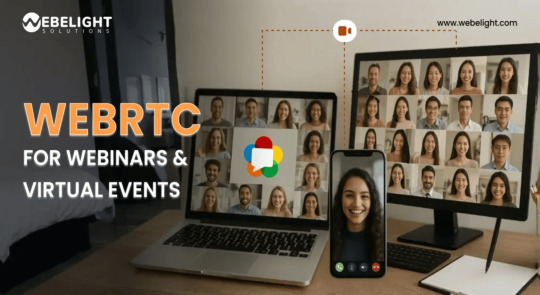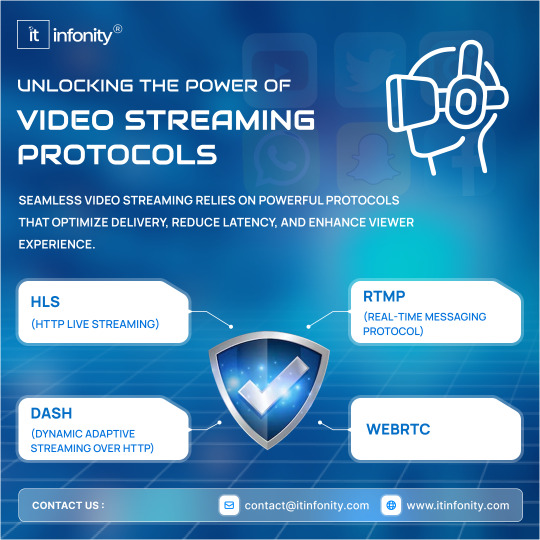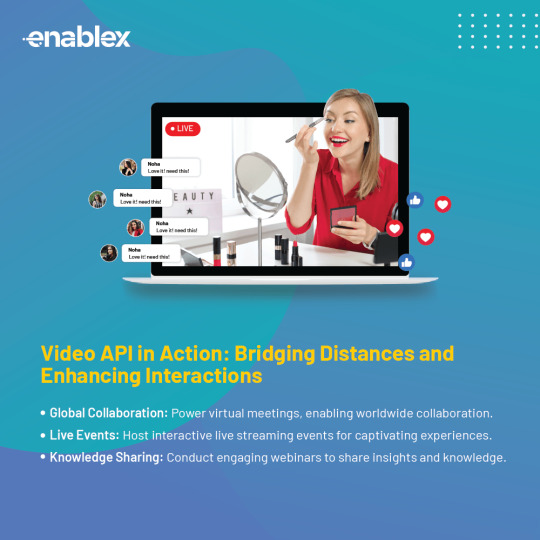#webRTC
Explore tagged Tumblr posts
Text
WebRTC Solutions for Scalable Webinars and Virtual Events

Explore how WebRTC technology is transforming virtual events. At Webelight Solutions, we provide scalable, interactive platforms that deliver real-time communication and seamless experiences, empowering businesses to host high-quality webinars and events. Learn more in our latest blog: WebRTC Solutions for Scalable Webinars and Virtual Events.
0 notes
Text
WebRTC Leaks Explained: Why They Matter and How to Stay Secure Online

In this day and age of hyper-connected digital space, WebRTC (Web Real-Time Communication) has set the standard for audio, video, and data to be transferred seamlessly over browsers. Yet, as it finds more usage, so does the fear of WebRTC leaks, which inadvertently reveal your IP address, even when connected through a VPN.
What is a WebRTC Leak?
A WebRTC leak occurs when your browser employs WebRTC to create P2P connections, evading VPN tunnels and exposing your true IP address to websites or evil actors. It compromises your anonymity online and endangers your privacy.
Why WebRTC Leaks Are Important
WebRTC leaks aren’t simply a privacy concern for privacy-conscious users — they’re a serious threat to enterprises and developers creating secure web applications. Leaked IP addresses can:
Compromise user privacy
Reveal internal network configurations
Act as a gateway for targeted attacks
If your app has any type of video or voice communication involved, it’s crucial to realize these dangers and actively test for vulnerabilities to protect it.
🔎 Curious about how to detect and avoid these leaks? Don’t miss our in-depth blog: How to Detect and Prevent WebRTC Leak Test
How to Prevent WebRTC Leaks
To prevent WebRTC leaks, take the following steps:
Turn off WebRTC in browser configurations (or employ browser add-ons that block it)
Enforce firewall rules blocking local IP address exposure
Properly configure STUN/TURN servers to handle traffic routing
Employ secure browser environments for real-time communication apps
Securing Applications with Professional Assistance
Creating secure and scalable WebRTC applications is not a plug-and-play affair — it needs a strong understanding of STUN/TURN configuration, signaling protocols, and NAT traversal approaches. That’s where professional assistance takes over.
If you’re creating bespoke VoIP or WebRTC-based solutions, it’s advisable to employ developers who know both the potential and risks of real-time communication.
💼 Need to create a secure and leak-free WebRTC application? Hire WebRTC Developers from our Experienced team and avail customized solutions with a focus on performance and confidentiality.
Final Thoughts
WebRTC leaks are a silent threat that can compromise both user trust and application security. Understanding how they occur and taking action to prevent them is critical for anyone developing VoIP or video solutions. By testing your systems and working with professionals like Hire VoIP Developer, you can deliver secure and reliable communication experiences without risking a data leak.
0 notes
Text

Unlocking the Power of Video Streaming Protocols!
From HLS to WebRTC, the right streaming protocol can make or break your video experience! Discover how these technologies enhance quality, reduce latency, and optimize performance.
0 notes
Text
Improving App Functionality with WEBRTC: Making real-time communication simple
Most of the applications today require features that allow real-time communication on your device. Since more and more users expect higher connectivity and better experiences, including voice calling, video chat, screen sharing, or other real-time features can mean the difference in a specific mobile app or a web application project. Simply doing this is one capability delivered by a technology called WebRTC.
Key Benefits
There are several important benefits WEBRTC offers for adding live calling, conferencing and collaboration features in mobile app development:
Built-in to Browsers: Being an open web implementation protocol that is supported by all current browsers, WEBRTC is best described as a write-on, run anywhere.
No Plug-ins Required: Because all the media processing and data transfer occurs between purely HTML-based applications in the browser, there is no need for browser plugins like Adobe Flash, which improves the accessibility of the solution.
Standard APIs: Like most Google products, WEBRTC has JavaScript APIs to enable developers to use those features in a reasonably straightforward and clear manner.
Low Latency Performance: Simplified procedures result in fast channels ensuring real-time communication.
Native App Access: WebRTC is available not only in web user interfaces but in native mobile applications as well when using the cross-platform framework React Native.
Enhanced Engagement: Mobile media capabilities make it easier for an application to provide users with prompt and interesting functionalities within the app.
New monetization opportunities emerge in audio, video and digital goods to support the offering as well.
Use Cases
There are a wide variety of use cases where real-time communications can convert applications:
Telehealth Apps: Applications include live remote diagnosis and treatment, remote patient monitoring, and home chemotherapy which can now be done through simple WebRTC video chat for content sharing and transfer of device data.
Into message, increased organization, and enterprise collaboration tools.
Support smooth video conferences, remote screens, messaging and many others in the teams that are distributed.
Online Learning & Tutoring: Virtual classrooms can perform such activities as lectures, discussions, tutoring and others.
Gaming & Entertainment: Audio/video chat within the application adds more fun to games and offers new ways how people can interact related to events.
E-commerce & Retail: Real-time attendant services through video communication when shoppers are engaged in shopping assist in offering directions.
Finance & Banking: Client appointments can be held even without having to be physically located in branches.
Final Words
WebRTC seems to be quite more than a sophisticated supplementary service that could be integrated to provide voice, video, and screen-sharing capabilities. WebRTC and new-generation web technologies make it easy to integrate real-time communications into an application or website using cross-platform integration and simple APIs. Improving nearly every application possible can be achieved by delivering such an intense and active user engagement level.
0 notes
Text
🚀 Discover the Basics of WebRTC! 🌐
Want to enhance your web communication experience?
Check out our beginner-friendly guide on WebRTC!
Learn about its simple APIs, examples in React and JavaScript, and how to integrate real-time communication effortlessly into your web applications.
Dive in now: Basics of WebRTC 📞💻
1 note
·
View note
Text
WebRTC 3A algorithms for Audio
AEC: Acoustic Echo Chancellor;
ANS: Automatic Noise Suppression;
AGC: Automatic Gain Control;
0 notes
Text
How to Integrate Video Calling Feature with WebRTC
Effective communication is a cornerstone for achieving success in today’s digital world. With the rising demand for seamless video communication, integrating a video calling feature into your application can be a game-changer. This article delves into the intricacies of integrating video calling with WebRTC, a powerful tool in the world of real-time communication.
What is WebRTC?
WebRTC, which stands for Web Real-Time Communication, is an open-source project that enables real-time communication capabilities directly within web browsers. Developed by the World Wide Web Consortium (W3C) and the Internet Engineering Task Force (IETF), WebRTC allows for peer-to-peer communication for audio, video, and data sharing without the need for plugins or additional software installations.
It is designed to provide a standardized and secure framework for browser-based communication, facilitating applications such as video conferencing, online gaming, and file sharing. WebRTC utilizes JavaScript APIs to enable seamless communication between browsers, making it a versatile and accessible solution for developers seeking to integrate real-time communication features into web applications.
Benefits of using WebRTC for Video Calling Feature
Utilizing WebRTC for video calling comes with numerous benefits. It ensures low latency, high-quality audio and video transmission, and a secure communication environment. Additionally, WebRTC’s peer-to-peer architecture enhances privacy and reduces dependence on external servers. The benefits of using WebRTC API for video calling are manifold:
· Real-Time Communication: WebRTC facilitates instant communication by enabling real-time audio and video streaming. This ensures a smooth and natural conversation experience, making it ideal for applications that require low-latency communication.
· Cross-Browser Compatibility: One of the significant advantages of WebRTC is its cross-browser compatibility. It works seamlessly on popular web browsers such as Chrome, Firefox, Safari, and Edge, eliminating the need for users to download additional plugins or software.
· Ease of Implementation: Implementing WebRTC is relatively straightforward, thanks to its open-source nature and extensive documentation. Developers can leverage the WebRTC API to integrate video calling features into their applications with ease, reducing development time and effort.
· Security and Encryption: WebRTC prioritizes security by implementing end-to-end encryption for video calls. This ensures that the communication remains confidential and protected from unauthorized access, making it a reliable choice for applications where privacy is a crucial concern.
· No Additional Software Installation: Unlike traditional video calling solutions that often require users to download and install specific software, WebRTC operates directly within the browser. This eliminates the friction associated with software installations, making it more user-friendly and accessible.
· Scalability: WebRTC is designed to handle a large number of concurrent connections efficiently. This scalability makes it suitable for applications ranging from one-on-one video calls to large-scale video conferences, meeting the diverse needs of various industries.
Role of Video Calling API for Integrating Video Calling Feature with WebRTC

The integration of Video Calling API plays a crucial role in incorporating the Video Calling feature within WebRTC applications. WebRTC, a free and open-source project, enables real-time communication capabilities directly in web browsers. However, to leverage video calling functionalities seamlessly, developers often turn to Video Calling APIs.
The Video API serve as a bridge between the application and the underlying WebRTC API, providing a simplified interface for developers to integrate video calling features effortlessly. By utilizing Video Calling APIs, developers can access essential functions such as initiating and terminating calls, handling user authentication, and managing video quality.
Moreover, these APIs often come with additional features like screen sharing, chat functionality, and call recording, enhancing the overall user experience. One such Video API is EnableX Video Call API, a robust solution designed to streamline the integration of video calling features into WebRTC applications.
This Video API provides developers with a comprehensive set of tools and resources, allowing them to seamlessly embed video calling functionalities into their web applications. This API supports a variety of platforms, making it versatile for different development environments.
Key Features of Video Calling API
EnableX Video Calling API offers a robust and versatile solution for integrating high-quality video communication into applications seamlessly. With an array of key features, this API empowers developers to create immersive and reliable video calling experiences for users.
Leveraging advanced technology, this video calling SDK ensures a secure and scalable platform, making it an ideal choice for businesses and developers looking to enhance their applications with real-time video calling. Here are some key features of the Video Calling API
1. High-Quality Video: The Video Calling API provides high-definition video streaming, ensuring clear and crisp visuals for an enhanced user experience.
2. Low Latency: The video API minimizes latency, delivering real-time communication and fostering smooth interactions between users.
3. Multi-Platform Support: The video calling API is versatile, supporting various platforms such as web, iOS, and Android, allowing seamless integration across devices.
4. Scalability: The API scales effortlessly to accommodate varying user loads, ensuring consistent performance even during peak usage.
5. Secure Communication: This video calling API prioritizes security, employing encryption measures to safeguard user data and maintain privacy during video calls.
6. Developer-Friendly: With a user-friendly interface and extensive documentation, developers find it easy to integrate and customize the video API within their applications.
7. Cross-Browser Compatibility: The API ensures compatibility across different web browsers, expanding the reach of video calling capabilities.
8. Interactive Features: The video calling API supports interactive features like screen sharing, file sharing, and chat, enhancing collaboration during video calls.
9. Customizable UI: Developers have the flexibility to customize the user interface to align with the branding and design preferences of their applications.
10. Recording and Playback: The Video API allows the recording of video calls for future reference, providing a valuable feature for various applications such as education and business meetings.
11. Analytics and Reporting: Developers can access analytics and reports to gain insights into user engagement, call quality, and other relevant metrics.
12. Network Resilience: The API is designed to handle network fluctuations, ensuring a stable connection and minimizing disruptions during video calls.
13. Integration with Third-Party Services: This video calling API seamlessly integrates with third-party services and applications, enhancing its functionality and expanding its use cases.
14. Virtual Waiting Rooms: Developers can implement virtual waiting rooms for users, adding an organized approach to managing and initiating video calls.
15. Global Reach: The API’s infrastructure spans globally, enabling developers to offer video calling services to users around the world with low-latency connections.
Steps to Integrate Video Calling Feature with WebRTC with Video Calling API
Integrating the Video Calling feature with WebRTC using the EnableX Video Call API involves several steps to ensure a seamless and effective implementation. Here is a brief overview of the key steps:
· Sign Up and Obtain API Credentials: Create an account on the EnableX platform and obtain API credentials (App ID and App Key) by creating a new project.
· Set Up a Server: Deploy a server to handle signaling between participants. However, ensure that the server is capable of securely exchanging information about the video call, such as session initiation and termination.
· Include WebRTC Library: Integrate the WebRTC library into your web application. This library enables real-time communication by supporting audio and video streaming between browsers.
· Initialize the video calling SDK: Initialize the Video Call SDK on the client side using the obtained App ID and App Key. Now, connect to the servers to establish a secure communication channel.
· Implement User Interface: Design and implement the user interface for the video calling feature. Also, include controls for starting, joining, and ending video calls.
· Handle Call Events: Set up event listeners to handle various call events, such as call initiation, participant joining, and call termination. Moreover, implement functions to manage user interactions during the call, such as muting, pausing, and switching cameras.
· Integrate Media Streams: Integrate the media streams provided by WebRTC to ensure smooth audio and video transmission. Therefore, handle media stream constraints and configurations based on user preferences.
· Implement Security Measures: Implement security measures to protect the video call from unauthorized access. Also, use secure protocols and encryption methods to safeguard user data during transmission.
· Test the Integration: Conduct thorough testing of the integrated solution to identify and resolve any potential issues. However, test under various network conditions to ensure optimal performance.
· Deploy and Monitor: Deploy the integrated video calling feature in a production environment. Furthermore, set up monitoring tools to track performance, identify bottlenecks, and address any issues that may arise during real-world usage.
FAQs
Q. Is WebRTC compatible with all browsers?
Yes, WebRTC is designed to be compatible with major web browsers, including Chrome, Firefox, Safari, and Edge.
Q. Can I use WebRTC for mobile app development?
Absolutely! WebRTC is not limited to browsers; it can be integrated into mobile applications for seamless video calling experiences.
Q. What makes EnableX Video Call API stand out?
This Video Call API stands out due to its high-definition video quality, adaptive bitrate streaming, and support for multi-party calls.
Q. How can I ensure the security of video calls in my application?
Implement end-to-end encryption, secure data transmission, and user authentication to ensure the security of video calls.
Q. Are there any upcoming trends in video calling that developers should watch out for?
Emerging trends include augmented reality features, advanced AI integrations, and improved video codecs shaping the future of video calling.
1 note
·
View note
Text
Build Real Time WebRTC Video Calling For Any App!
Develop a secure peer-to-peer (P2P) video calling app with 500+ features, 99.999% uptime SLA and ultra-low latency with MirrorFly low code SDK & APIs.
Real-time WebRTC video APIs & SDK for developers to develop secure video chat apps for Android, iOS & Web platforms.
0 notes
Text
WebRTC Explained: Everything You Need to Know for Seamless Communication

Introduction
Ever been curious about how video calls are made without having to install additional software? That’s the wonder of WebRTC! Whether you’re making use of a browser-based video conferencing or a live collaboration app, WebRTC makes it possible. But what is WebRTC, really, and how does it enable smooth communication? Let’s explain it in layman terms.
What Is WebRTC?
WebRTC (Web Real-Time Communication) is an open-source technology that facilitates real-time sharing of audio, video, and data directly via web browsers. No plugins, no third-party applications — just smooth communication. It’s the foundation for applications such as Google Meet, WhatsApp Web, and even customer support chatbots.
In plain terms, WebRTC enables two or more devices to communicate directly for voice and video calls, without the intervention of an external server to handle everything. This means lower latency, improved quality, and enhanced privacy.
How Does WebRTC Work?
WebRTC is based on three fundamental technologies:
GetUserMedia — Provides access to a device’s camera, microphone, and screen sharing.
RTCPeer Connection — Manages peer-to-peer communication, making sure data is transferred smoothly.
RTC Data Channel — Enabling real-time data exchange among users, so file sharing and chat functionality becomes feasible.
Consider it as a direct connection between users, with less need for middlemen and faster, more efficient connections.
Why Is WebRTC a Game-Changer?
WebRTC is extensively utilized in:
✅ Video Conferencing: WebRTC is depended upon by Zoom, Google Meet, and Microsoft Teams for lag-free, smooth calls.
✅ Live Streaming: WebRTC is utilized by Facebook Live and Twitch for live broadcasting.
✅ Online Gaming: WebRTC is utilized by multiplayer browser games for low-latency communication.
✅ Customer Support & Telehealth: Companies utilize WebRTC for live assistance as well as remote health services.
WebRTC Architecture: What’s Under the Hood?
Fundamentally, WebRTC architecture consists of:
Media Stream API: Controls audio and video input.
Signaling Server: Facilitates users to locate and connect with one another.
STUN/TURN Servers: Fix NAT traversal problems (assist users in connecting behind firewalls).
These components together provide seamless communication, even over various networks.
Challenges of WebRTC & How to Solve Them
WebRTC is robust, but yes, it does have challenges:
Network Restrictions: Firewalls and NAT can intercept direct connections. STUN/TURN servers can assist.
Latency & Bandwidth Issues: Slow internet can lead to lag. Adaptive bitrate streaming can help optimize video quality.
Security Issues: Since WebRTC supports direct communication, encryption is imperative (such as DTLS and SRTP) to secure the data.
WebRTC Future: What’s Ahead?
The WebRTC future promises to be grand! With growing developments in AI, 5G, and edge computing, we can expect still lower latency, better quality video, and more intelligent real-time communication technology. Developers and businesses are hard at work deploying WebRTC to even more sectors, ranging from finance to education.
Final Thoughts
WebRTC has revolutionized real-time communication to become faster, easier, and more accessible. As a developer, business leader, or someone who loves effortless video calls, WebRTC is revolutionizing how we connect online.
If you’re interested in incorporating WebRTC solutions into your company or need expert advice, our WebRTC developers at Hire VoIP Developer can assist you in developing scalable, high-quality real-time applications.
#Webrtc#Webrtc technology#VoIp Solutions#Webrtc developer#Hire webrtc developers#deploying webrtc#hire voip developers
0 notes
Text
How Artificial Intelligence can be used in PNS solutions?
Artificial Intelligence can enhance private networking solutions. It can help in automating tasks and provide an interactive voice response.
A private networking solution that uses Artificial Intelligence can offer better service to the users. It is possible to integrate AI into WebRTC, an application used for real-time communication. NEC India’s InUC, a unified communications system, has a WebRTC API for real-time communication.
WebRTC API enables a user to set up a video or audio connection using a VPN or LAN connection. Most communication systems do not use non-verbal cues. Interactive voice response is a feature that can be enhanced with the help of AI.

A unified communication system can be enabled with WebRTC to capture and stream audio and video media in real-time. Instant messaging is also possible between browsers.
WebRTC does require users to install plug-ins or any other third-party software. It consists of several protocols which work together to achieve real-time communication.
AI algorithms can analyze network traffic patterns, predict usage trends, and dynamically allocate resources to optimize network performance. By continuously monitoring network conditions and adjusting configurations in real-time, AI-powered PNS solutions can ensure maximum bandwidth utilization, minimize latency, and improve overall network efficiency.
Unauthorized access attempts can be prevented with the help of AI. By leveraging machine learning algorithms, PNS solutions can detect and respond to security incidents in real time, handling risks and preventing data breaches.
PNS solutions equipped with AI capabilities can automatically deploy and configure network devices, optimize session initiation protocol, and perform routine maintenance tasks, allowing IT teams to focus on strategic initiatives rather than routine operational tasks.

AI algorithms can analyze traffic patterns and adjust network routing and QoS (Quality of Service) policies dynamically to prioritize critical applications and ensure optimal performance. PNS solutions equipped with AI-driven traffic engineering capabilities can adapt to changing network conditions, reroute traffic to avoid congestion, and allocate resources based on application requirements, enhancing user experience and productivity.
Source referred
#ai algorithms#Artificial Intelligence#nec corporation india#digital technology#WebRTC#PNS solutions#neci#private networking solutions
0 notes
Text
Elevate Your Real-Time Communication with Enfin Technologies: The Premier WebRTC App Development Company
In today’s fast-paced digital landscape, real-time communication stands as the cornerstone of connectivity for businesses worldwide. With remote work and virtual collaboration becoming the norm, the demand for seamless and secure communication solutions is higher than ever. This is where Enfin shines as a leading WebRTC app development company, offering tailored solutions to meet the diverse needs of businesses across industries.
Enfin : Your Trusted Partner for WebRTC App Development
At enfin , we’re dedicated to pushing the boundaries of real-time communication technology. As a premier WebRTC app development company, we leverage cutting-edge tools and methodologies to craft innovative solutions that empower businesses to connect, communicate, and collaborate effortlessly.
Customized Solutions to Suit Your Unique Requirements
Every business is unique, and we understand that one size doesn’t fit all. That’s why we take a personalized approach to every project, collaborating closely with our clients to understand their specific needs and objectives. Whether you’re looking to build a video conferencing platform, a live streaming application, or a peer-to-peer messaging solution, enfin has the expertise to bring your vision to life.
User-Centric Design for Enhanced User Experience
A successful WebRTC application puts user experience at the forefront. That’s why we prioritize user-centric design principles in our development process. Our applications are intuitive, user-friendly, and visually appealing, ensuring seamless navigation and crystal-clear audio and video quality. With enfin, users can enjoy an unparalleled communication experience that fosters engagement and productivity.
Scalable and Flexible Solutions for Long-Term Success
We understand that businesses evolve over time, and scalability is essential for sustained growth. Our WebRTC applications are designed to scale seamlessly, whether you’re serving a handful of users or millions of concurrent connections. With enfin, you can rest assured that your communication platform will adapt to meet your evolving needs, ensuring a seamless experience for all users.
Robust Security Measures to Protect Your Data
Security is paramount in real-time communication applications, and we take it seriously. enfin implements robust encryption, authentication, and access control measures to safeguard your data and ensure privacy and confidentiality. With our solutions, you can communicate with confidence, knowing that your sensitive information is protected against unauthorized access and cyber threats.
Comprehensive Support and Maintenance for Peace of Mind
Our commitment to customer satisfaction extends beyond the development phase. enfin
provides comprehensive support and maintenance services to ensure that your WebRTC application operates smoothly and efficiently at all times. From troubleshooting technical issues to implementing updates and enhancements, our dedicated team is here to support you every step of the way.
Unlock the Power of Real-Time Communication with enfin
In today’s digital age, effective communication is essential for success. With enfin as your trusted partner, you can unlock the power of real-time communication and take your business to new heights. Contact us today to learn more about our WebRTC app development services and how we can help you achieve your goals.
0 notes
Text
Live Streaming API: Enhancing the Digital Experience
Looking for a perfect live streaming API for your social media platforms and e-commerce websites to gaming and entertainment, then you landed on the right blog post. In this blog you will acknowledge alot about Live Streaming API, it’s use cases and even the best API among all. Understanding Live streaming API A Live Streaming API, or Video API is a set of rules and protocols that enable…

View On WordPress
0 notes
Text
Explain About WebRTC Media Server: How to Choose Them Wisely?
Communication obstacles are lessened by using WebRTC. This game-changing solution makes use of plugin-free APIs and works in desktop and mobile browsers. Nearly all of the main browser vendors today support integrate webrtc technology. External plugins were required to perform the same tasks prior to the invention of WebRTC Media.
Read more: https://bit.ly/47lZFO8

1 note
·
View note